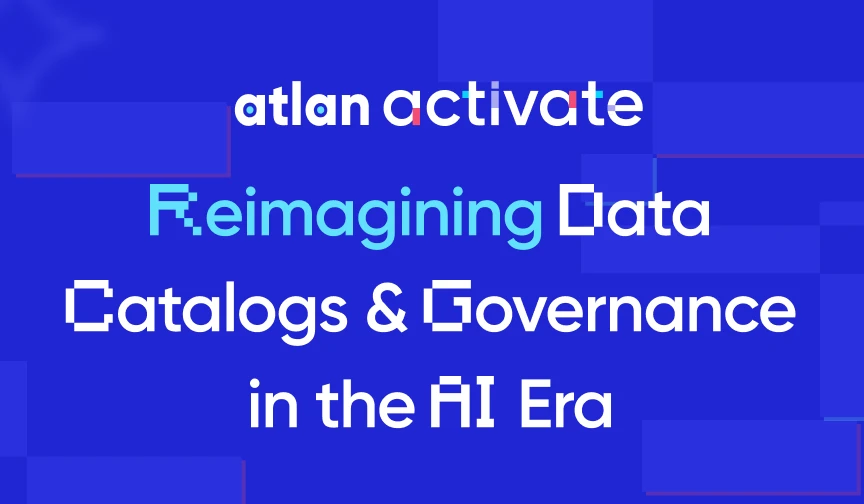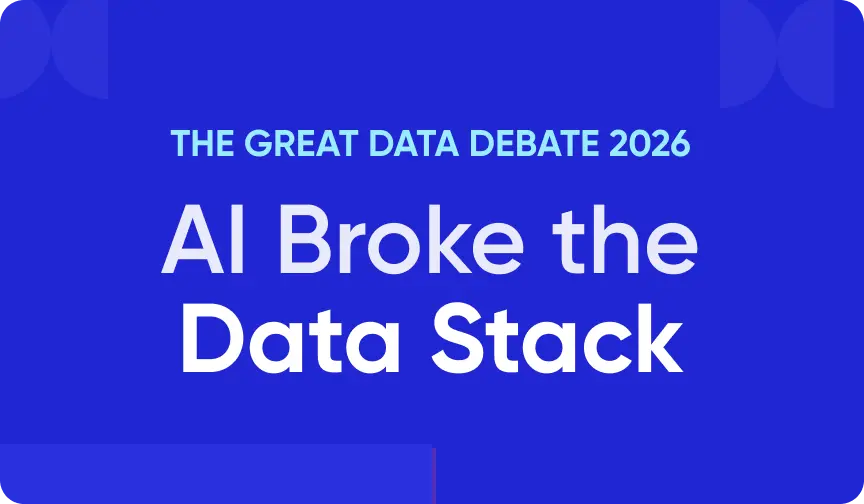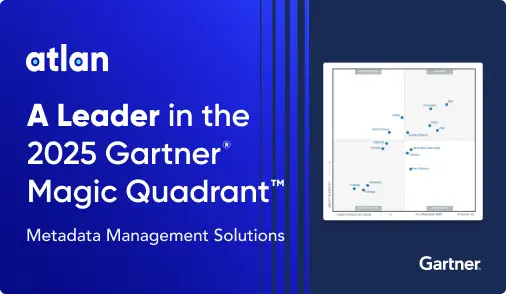Data Classification Tools in Finance: What Evaluation Qualities & Criteria Matter in 2025

Last Updated on: April 29th, 2025 | 9 min read
Unlock Your Data's Potential With Atlan

Data classification tools in finance automatically identify, label, and categorize financial data assets based on business relevance, risk level, and regulations.
Financial institutions today manage billions of data points across transactions, customer records, credit scoring, trading activity, and regulatory reporting. Data classification tools are essential for organizing and protecting this information while meeting growing regulatory expectations.
In this article, we cover:
- Core capabilities of financial data classification tools
- Key evaluation criteria, benchmarks, and scoring frameworks
- Common pitfalls financial institutions should avoid
- How a modern data catalog like Atlan simplifies data classification for financial institutions
Table of Contents
Permalink to “Table of Contents”- What qualities should you look for in financial data classification tools?
- How to evaluate data classification tools for finance
- What are some of the most common pitfalls when choosing a data classification tool?
- How does Atlan enable data classification for financial institutions?
- Wrapping up
- Data classification tools in finance: Frequently asked questions (FAQs)
What qualities should you look for in financial data classification tools?
Permalink to “What qualities should you look for in financial data classification tools?”Data classification supports everything from risk assessments and audit readiness to regulatory reporting and customer privacy protections. So, while evaluating options, you should prioritize the following qualities:
- Core classification capabilities: Look for automated tagging, labeling, and metadata-driven classification features.
- Support for all data types: Financial data can include contracts (unstructured), chat logs (semi-structured), market feeds (streaming), and more. The data classification tool must handle them all seamlessly.
- Enterprise scalability: Ensure the tool can handle billions of rows, petabytes of transactions, thousands of data products—and do so without manual bottlenecks or loss of governance traceability.
- Integration across cloud and on-prem systems: The tools should be capable of classifying data where it lives—across Snowflake, AWS, Azure, on-prem databases, and regulatory reporting systems.
- Bi-directional sync with source metadata: Look for tools that keep classification tags and metadata synchronized between systems, ensuring accuracy during audits, data migrations, and compliance reviews.
Also, read → Marie Kondo your data catalog and spark joy with data classification & tagging
How to look beyond features: Six critical dimensions to evaluate
Permalink to “How to look beyond features: Six critical dimensions to evaluate”A powerful financial data classification tool should perform well across these six critical areas:
- Accuracy: Can the tool consistently identify personal information, financial data types, and regulatory-relevant categories without false positives?
- Flexibility: Can it align with custom definitions (e.g., credit risk categories, Basel III reporting fields, GDPR-sensitive data types)?
- Automation: Does it offer rule-based workflows, AI enrichment, or pattern-matching to classify assets across millions of rows?
- Governance integration: Does classification automatically feed access controls (e.g., masking PII), data retention policies, and breach alerting mechanisms?
- Lineage awareness: Can the tool track how classified data flows downstream into reports, dashboards, or models?
- User experience: Is it no-code friendly for data stewards and intuitive for risk, compliance, and business users?
How to evaluate data classification tools for finance
Permalink to “How to evaluate data classification tools for finance”Beyond feature lists, financial firms must ensure real-world performance and fit. Here’s a structured evaluation approach to help you avoid biases and ensure alignment with your institution’s regulatory needs:
- Run a proof-of-concept (PoC)
- Track key metrics
- Ask targeted questions
- Use a scoring framework
1. Run a proof-of-concept (PoC)
Permalink to “1. Run a proof-of-concept (PoC)”Test across real financial datasets, including sensitive payment information, regulatory filings, and customer PII. Validate that classification is accurate, fast, and scalable without extensive custom coding.
2. Track key metrics
Permalink to “2. Track key metrics”Key metrics to measure the effectiveness of a data classification tool include (but aren’t limited to):
- Classification precision and recall: Accuracy in identifying sensitive or regulated data (like account numbers, SSNs, credit ratings, etc.)
- Coverage percentage: Share of total data assets correctly classified
- Time to classify: Speed at enterprise scale
- Metadata enrichment rate: Business context (like business terms, tags, sensitivity labels) added to classified assets
- Rule hit rate: Automation success without manual overrides
- Auto-suggestion accuracy: Accuracy of AI-driven classification suggestions
3. Ask targeted questions during evaluation
Permalink to “3. Ask targeted questions during evaluation”During the evaluation, you should ask targeted questions to tool vendors on setup and implementation, use cases, success stories, and more:
- How customizable are the classification models for financial data domains?
- Can it integrate natively with your cloud providers, reporting engines, banking systems, risk platforms, etc.?
- How does the tool handle hybrid data architectures?
- How does classification integrate with lineage, access control, and compliance tools?
- How are audit logs and classification version histories managed?
- How is classification performance monitored post-deployment (dashboards, alerts, metrics)?
- How are conflicts handled if different systems tag the same asset differently?
- What real-world precision/recall benchmarks can you share based on client deployments from the finance industry?
- How customizable are the AI models or rule engines—can you tune them to your data domains without vendor dependency?
4. Set up a scoring framework to compare data classification tools
Permalink to “4. Set up a scoring framework to compare data classification tools”Create a weighted matrix based on your institution’s priorities across dimensions like:
- Accuracy
- Automation
- Lineage integration
- Governance alignment
- Ease of extensibility
- Total cost of ownership (TCO)
What are some of the most common pitfalls when choosing a data classification tool?
Permalink to “What are some of the most common pitfalls when choosing a data classification tool?”The most common pitfalls when evaluating data classification tools include:
- Focusing only on fingerprinting without metadata context: Content scans aren’t enough. You need metadata context – ownership metadata, lineage, business domain tagging, and usage data for accurate, effective classification.
- Underestimating operational overhead: Manual tagging and ad-hoc rule creation are not sustainable. Prioritize AI-assisted, bulk, and playbook-driven classification.
- Ignoring downstream governance use cases: Classification must tie directly into access policies, DLP, regulatory disclosures (e.g., GDPR DSARs, Basel III risk reports). Choose tools that integrate classification with actionable governance.
- Choosing closed systems: Tools that cannot sync metadata bidirectionally with cloud data warehouses, BI tools, catalogs, and governance platforms create silos and compliance blind spots. So, pick tools built on an open architecture, supporting endless extensibility.
Also, read → Role of metadata management in enterprise AI
How does Atlan enable data classification for financial institutions?
Permalink to “How does Atlan enable data classification for financial institutions?”Atlan acts as a metadata control plane that offers a turnkey, extensible framework for discovering, tagging, and governing sensitive and regulated data. As a result, you can meet PCI-DSS, GDPR, GLBA, FINRA, SOX and other requirements without heavy custom engineering.
Atlan’s classification framework is built to be open and extensible—so you can pull in tag/label data from any external classifier and bake it into your metadata, lineage and policy workflows.
“Bi-directional tagging was a unique (Atlan) feature we did not see in other offerings.” - Gabrielle Tyll, Senior VP at SouthState Bank, on what made Atlan stand out
With Atlan, financial institutions are equipped with key classification and governance capabilities, such as (but not limited to):
- Get out-of-the-box classifiers for common financial PII/PHI fields, such as credit card numbers, account numbers, routing numbers, SWIFT codes, SSNs, and tax IDs
- Automate classification workflows using rule-based playbooks tied to metadata patterns
- Use the no-code policy center to author custom classification rules (regex, keyword dictionaries, conditional logic) for institution-specific products (mortgages, derivatives, insurance claims)
- Integrate external classifiers like AWS Macie, Azure Purview, Google Cloud DLP, and third-party DLP platforms
- Leverage bi-directional tag sync to push Atlan’s labels back into Snowflake (for dynamic masking) or your SIEM/GRC tools
- Enrich assets with granular tag values like email, transaction ID, etc.
- Propagate classifications through lineage to downstream reports and analytics
- Use built-in dashboards to track classification coverage (e.g., “% of financial tables with PCI tags”), policy violations, review SLAs and remediation progress
Also, read → Tags in Atlan | Setting up playbooks in Atlan | Tag propagation in Atlan
By combining automation, extensibility, and transparency, Atlan enables financial data teams to embed trust and compliance into every layer of their data estate.
How North scaled data classification and compliance with automation
Permalink to “How North scaled data classification and compliance with automation”As a payments solution provider processing $100+ billion in annual transactions, North handles vast amounts of sensitive financial data. North’s data team used Snowflake’s Dynamic Data Masking (DDM) to secure sensitive data and enforce data access policies for data security and regulatory compliance.
Using DDM required identifying specific data assets that required these policies. Given the scale and complexity of North’s data landscape, this would be a time-consuming, potentially error-prone endeavor.
North chose to use Atlan Playbooks, rules-based bulk automations that could identify thousands of assets based on selected criteria, then automatically apply actions, such as adding chosen tags and policies.
The team then used Atlan’s Two-way Tag Sync to enable DDM, automatically applying masking policies based on how and from whom data was queried. This led to a 700% increase in tagged Snowflake assets, saving millions of dollars in risk.
“We’ve used Atlan to boost the speed and accuracy of our asset tagging by more than 700% since implementation. With the ability to discover data faster, apply tags, and reverse sync that data back into Snowflake, we added more than 2,000 governance assets in under a year.” - Daniel Dowdy, Vice President of Data Analytics & Governance at North
Wrapping up
Permalink to “Wrapping up”Choosing the right data classification tool in finance means ensuring that sensitive data is accurately identified, responsibly handled, and consistently governed—no matter how fast your systems or regulations evolve.
Modern data catalogs like Atlan provide the metadata control plane needed to scale classification, automate governance, and drive financial innovation.
Explore how a unified metadata control plane like Atlan can simplify your compliance, governance, and innovation journey. Get hands-on with Atlan today.
Data classification tools in finance: Frequently asked questions (FAQs)
Permalink to “Data classification tools in finance: Frequently asked questions (FAQs)”1. What is a data classification tool in finance?
Permalink to “1. What is a data classification tool in finance?”A data classification tool in finance ensures that sensitive financial data—like customer information, trading data, and regulatory disclosures—is protected, auditable, and compliant.
2. What are some examples of sensitive financial data to classify?
Permalink to “2. What are some examples of sensitive financial data to classify?”Examples include PII (like Social Security Numbers), PCI data (credit card numbers), trading records, loan documents, and regulatory filings.
3. How can data classification help with regulatory audits?
Permalink to “3. How can data classification help with regulatory audits?”Data classification provides structured, searchable audit trails of sensitive data, making it easier to respond to regulatory reviews or breach investigations.
4. What core capabilities should financial data classification tools have?
Permalink to “4. What core capabilities should financial data classification tools have?”Essential capabilities include:
- Automated tagging and metadata-based classification
- Support for multiple data types
- Lineage-aware propagation
- Bi-directional sync with data platforms
- Governance integration
- Extensibility and interoperability across hybrid environments
5. How does automation help financial data classification?
Permalink to “5. How does automation help financial data classification?”Automation scales classification across billions of rows, reduces manual tagging errors, and embeds compliance into fast-changing datasets.
6. Why is bi-directional sync with source systems important?
Permalink to “6. Why is bi-directional sync with source systems important?”Bi-directional sync ensures that changes to classification or metadata in source systems (like Snowflake or dbt) are automatically reflected in the governance platform, maintaining consistency and reducing manual effort.
7. Why is lineage awareness important for financial data classification?
Permalink to “7. Why is lineage awareness important for financial data classification?”Lineage tracks how sensitive data flows into reports, models, and dashboards—ensuring consistent compliance and faster audits.
8. What are some examples of data classification tools for finance?
Permalink to “8. What are some examples of data classification tools for finance?”Atlan offers modern classification and governance capabilities purpose-built for complex, hybrid financial environments. Key capabilities include:
- Rule-based automation through Playbooks
- Integration with external classifiers
- Granular tag-based classification
- Lineage-aware propagation of classifications
Share this article
Atlan is the next-generation platform for data and AI governance. It is a control plane that stitches together a business's disparate data infrastructure, cataloging and enriching data with business context and security.
Data classification tools in finance: Related reads
Permalink to “Data classification tools in finance: Related reads”- Data Classification: Definition, Types, Examples, Tools
- Data Classification and Tagging: Marie Kondo Your Data Catalog
- What is Data Governance? Its Importance, Principles & How to Get Started?
- Data Governance and Compliance: An Act of Checks & Balances
- Data Governance and GDPR: A Comprehensive Guide to Achieving Regulatory Compliance
- Data Compliance Management in 2025
- Enterprise Data Governance Basics, Strategy, Key Challenges, Benefits & Best Practices
- Data Governance in Banking: Benefits, Challenges, Capabilities
- Financial Data Governance: Strategies, Trends, Best Practices
- BCBS 239 Data Governance: What Banks Need to Know in 2025
- Data Governance & Business Intelligence: Why Their Integration Matters and How It is Crucial for Business Success?
- Unified Control Plane for Data: The Future of Data Cataloging





















